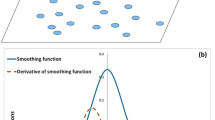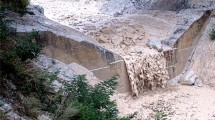Abstract
FLATModel is a two-dimensional shallow-water approximation code with corrections and modifications that create a simulation tool adapted to debris-flows behaviour. FLATModel uses the finite volume method with the numerical implementation of the Godunov scheme and includes correction terms regarding the effect of flow over high slopes and curvature. Additionally, the stop-and-go phenomenon, the basal entrainment and a correction regarding the front inclination of the final deposit are incorporated into FLATModel. In addition, different flow resistance laws were integrated in the numerical code including Bingham, Herschel–Bulkley and Voellmy fluid model. Firstly, our numerical model was validated using analytical solutions of a dam-break scenario and published data on a laboratory experiment. Secondly, three real events, which occurred in the northeastern part of the Iberian Peninsula, were back-calculated. Although field observations of the three events are not very detailed, the back-analyses revealed interesting patterns on the flow dynamics, and the numerical results generally showed good agreement with field data. Comparing the different flow resistance laws, the Voellmy fluid model presents the best behaviour regarding both the flow behaviour and the deposit characteristics. Preliminary simulation runs incorporating the effect of basal entrainment offered satisfactory results, although the final volume is rather sensitive on the selected friction angle of channel-bed material. The outcomes regarding the correction of the calculated front inclination of the final deposit showed that this implementation strongly improves the simulation results and better represents steep fronts of final deposits.













Similar content being viewed by others
References
Atkin RJ, Craine RE (1976) Continuum theories of mixtures: basic theory and historical development. Q J Mech Appl Math 29(2):209–244
Bateman A, Granados A, Medina V, Velasco D, Nalesso M (2006) Experimental procedure to obtain 2D time-space high-speed water surfaces. In: Ferreira R, Alves E, Leal J, Cardoso A (eds) RiverFlow2006. Taylor and Francis, Lisbon, pp 1879–1888
Bateman A, Medina V, Hürlimann M, Velasco D (2007) Modelo bidimensional para simulación de flujos detríticos: FLATModel. Aplicación a una cuenca del Pirineo Catalán. Ing Hidrául Méx XXII(4):5–20
Bingham EC (1922) Fluidity and plasticity. McGraw Hill, New York, p 440
Boussinesq J (1877) Essai sur la theorie des eaux courantes 23. Mémories présentés par divers savants à l’Académie des Sciences, Paris, pp 1–680
Bru J, Serrat D, Vilaplana JM (1984) La dinámica geomorfológica de la cuenca del Torrente de Jou - La Guingueta (Noguera Pallaresa). In: ETSECCPB (ed) Inestabilidad de laderas en el Pirineo. ETSI Caminos, Canales y Puertos, Barcelona, pp 1.2.1–1.2.9
Chen C, Lee CF (2002) Runout analysis of slurry flows with Bingham model. J Geotech Geoenviron Eng 128(12):1032–1042
Chen H, Lee CF (2003) A dynamic model for rainfall-induced landslides on natural slopes. Geomorphology 51(4):269–288
Corominas J, Moya J, Hürlimann M (2002) Landslide rainfall triggers in the Spanish Eastern Pyrenees. In: Proceedigns of 4th EGS Plinius Conference “Mediterranean Storms”. Editrice, Mallorca
Coussot P (1994) Steady, laminar flow of concentrated mud suspensions in open channel. J Hydraul Res 32(4):535–559
Coussot P, Laigle D, Arattano M, Deganutti A, Marchi L (1998) Direct determination of rheological characteristics of debris flow. J Hydraul Eng 124(8):865–868
Denlinger RP, Iverson RM (2001) Flow of variably fluidized granular masses across three-dimensional terrain 2. Numerical predictions and experimental tests. J Geophys Res B Solid Earth 106(1):553–566
Denlinger RP, Iverson RM (2004) Granular avalanches across irregular three-dimensional terrain: 1. Theory and computation. J Geophys Res 109(F1):F01014, DOI 10.1029/2003JF000085
Dressler RF (1978) New nonlinear shallow flow equations with curvature. J Hydraul Res 16(3):205–220
Egashira S, Honda N, Itoh T (2001) Experimental study on the entrainment of bed material into debris flow. Phys Chem Earth, Part C: Solar, Terrestrial Planetary Science 26(9):645–650
Fenton JD (1996) Channel flow over curved boundaries and new hydraulic theory. In: Proceedings of 10th Congress, Asia and Pacific Division of International Association for Hydraulic Research, Langkawi, Malaysia, pp 266–273
Fraccarolo L, Capart H (2002) Riemann wave description of erosional dam-break flows. J Fluid Mechanics 461:183–228
Gray JMNT, Wieland M, Hutter K (1999) Free surface flow of cohesionless granular avalanches over complex basal topography. Proc R Soc Lond 455:1841–1874
Hungr O (1995) A model for the runout analysis of rapid flow slides, debris flows, and avalanches. Can Geotech J 32(4):610–623
Hürlimann M, Corominas J, Moya J, Copons R (2003) Debris-flow events in the Eastern Pyrenees. Preliminary study on initiation and propagation. In: Rickenmann D, Chen C (eds) Proceedings of 3rd Int. Conf. on Debris-Flow Hazards Mitigation. Millpress, Davos, pp 115–126
Hutter K, Siegel M, Savage SB, Nohguchi Y (1993) Two dimensional spreading of a granular avalanche down an inclined plane. Part I. Theory. Acta Mech 100:37–68
Imran J, Parker G, Locat J, Lee H (2001) 1D numerical model of muddy subaqueous and subaerial debris flows. J Hydraul Eng 127(11):959–968
Iverson RM, Denlinger RP (2001) Flow of variably fluidized granular masses across three-dimensional terrain - 1. Coulomb mixture theory. J Geophys Res 106:537–552
Iverson RM, Logan M, Denlinger RP (2004) Granular avalanches across irregular three-dimensional terrain. 2. Experimental tests. J Geophys Res 109(F1):F01015, DOI 10.1029/2003JF000084
Jin M, Fread DL (1999) 1D modeling of mud/debris unsteady flows. J Hydraul Eng 125(8):827–834
Johnson AM, Rodine JR (1984) Debris flow. In: Brunsden D, Prior DB (eds) Slope stability. Wiley, New York, pp 257–361
Laigle D, Coussot P (1997) Numerical modelling of mudflows. J Hydraul Eng 123(7):617–623
Leveque RJ (2002) Finite volume methods for hyperbolic problems. Cambridge Texts in Applied Mathematics. Cambridge University Press, Cambridge
Mangeney A, Heinrich P, Roche R (2000) Analytical solution for testing debris avalanche numerical models. Pure Appl Geophys 157(6):1081–1096
McDougall S, Hungr O (2004) A model for the analysis of rapid landslide motion across three-dimensional terrain. Can Geotech J 41:1084–1097
Medina V, Bateman A, Velasco V (2006) A new approach to solving boundary conditions in shallow water equations using a Riemann solver. In: Ferreira R, Alves E, Leal J, Cardoso A (eds) RiverFlow2006. Taylor and Francis, Lisbon, pp 1443–1452
Mitasova H, Mitas L (1993) Interpolation by regularized spline with tension. I. Theory and implementation. Math Geol 25:641–655
Naef D, Rickenmann D, Rutschmann P, McArdell BW (2006) Comparison of flow resistance relations for debris flows using a one-dimensional finite element simulation model. Nat Hazards Earth Syst Sci 6:155–165
O’Brien JS, Julien PY, Fullerton WT (1993) Two-dimensional water flood and mudflow simulation. J Hydraul Eng 119(2):244–261
Papa M, Egashira S, Itoh T (2004) Critical conditions of bed sediment entrainment due to debris flow. Nat Hazards Earth Syst Sci 4(3):469–474
Pastor M, Quecedo M, Gonzalez E, Herreros MI, Fernandez JA, Mira P (2004) Simple approximation to bottom friction for Bingham fluid depth integrated models. J Hydraul Eng 130(2):149–155
Pitman EB, Nichita CC, Patra A, Bauer A, Sheridan MF, Bursik M (2003) Computing debris flows and landslides. Phys Fluids 15(12):3638–3646
Pudasaini SP, Wang Y, Hutter K (2005) Modelling debris flows down general channels. Nat Hazards Earth Syst Sci 5(6):799–819
Quecedo M, Pastor M, Herreros MI, Merodo JAF (2004) Numerical modelling of the propagation of fast landslides using the finite element method. Int J Numer Methods Eng 59(6):755–794
Rickenmann D, Koch T (1997) Comparison of debris flow modeling approaches. In: Chen C (ed) Proceedings of 1st Int. Conf. on Debris-Flow Hazards Mitigation, San Francisco, pp 576–585
Rickenmann D, Weber D, Stepanov B (2003) Erosion by debris flows in field and laboratory experiments. In: Rickenmann D, Chen C (eds) Proceedings of 3rd Int. Conf. on Debris-Flow Hazards Mitigation. Millpress, Davos, pp 883–894
Rickenmann D, Laigle D, McArdell B, Hübl J (2006) Comparison of 2D debris-flow simulation models with field events. Comput Geosci 10(2):241–264
Syamlal M, Rogers W, O’Brien JS (1993) MFIX documentation: theory guide. Technical note, DOE/METC-94/1004, NTIS/DE94000087. National Technical Information Service, Springfield, VA
Takahashi T, Nakagawa H, Harada T, Yamashiki V (1992) Routing debris flows with particle segregation. J Hydraul Eng 118(11):1490–1507
Toro EF, Spruce M, Speares W (1994) Restoration of the contact surface in the Harten-Lax-van Leer Riemann Solver. J Shock Waves 4:25–34
Voellmy A (1955) Über die Zerstörungskraft von Lawinen. Schweiz Bauztg 73:212–285
Vreugdenhil CB (1994) Numerical methods for shallow-water flow. Kluwer, Norwell, MA, p 261
Zanuttigh B, Lamberti A (2004) Numerical modelling of debris surges based on shallow-water and homogeneous material approximations. J Hydraul Res 42(4):376–389
Acknowledgements
This research was supported by the Spanish Research and Technology Ministry, contract BTE2002-0375, the EC-project HYDRATE, contract GOCE 037024 and the Generalitat de Catalunya, research group 2005SGR00770.
Author information
Authors and Affiliations
Corresponding author
Rights and permissions
About this article
Cite this article
Medina, V., Hürlimann, M. & Bateman, A. Application of FLATModel, a 2D finite volume code, to debris flows in the northeastern part of the Iberian Peninsula. Landslides 5, 127–142 (2008). https://doi.org/10.1007/s10346-007-0102-3
Received:
Accepted:
Published:
Issue Date:
DOI: https://doi.org/10.1007/s10346-007-0102-3




